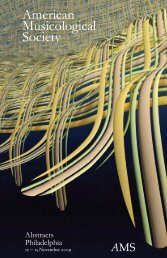Abstracts - American Musicological Society
Abstracts - American Musicological Society
Abstracts - American Musicological Society
Create successful ePaper yourself
Turn your PDF publications into a flip-book with our unique Google optimized e-Paper software.
54 FridaY afternoon<br />
only on musical life under the dukes of Lorraine, but<br />
also under the Val-ois kings of France.<br />
This paper will focus upon the years around 1530,<br />
a time of close political and musical bonds between the<br />
courts of Lorraine and France. Chronicles,<br />
ambassadorial dispatches, and unpublished archival<br />
docunents collectively show that singers and<br />
instrumentalists accompanied Duke Antoine on official<br />
visits to the kingdom of France. One such musician was<br />
Mathieu Lasson, mattre des enfants of the ducal chapel<br />
at Nancy and a composer of chansons and motets.<br />
Examination of Lasson's music suggests that the<br />
composer was well-aware of the stylistic vogue then in<br />
ful1 swing at Paris--a style typified by certain r,rorks<br />
of Claudin de Serrnisy. Moreover, two ftagmentary music<br />
manuscripts I recently discovered at Nancy show that<br />
rrorks from Parisian circles (including at least one by<br />
Claudin hinself) were known at the court of Lorraine by<br />
1534- -precisely when pieces by Mathieu Lasson first<br />
appeared in the offerings of the royal music printer,<br />
Pierre Attaignant.<br />
Together, this new musical and archival evidence<br />
helps to reveal a 1ike1y mechanism of artistic<br />
interchange. And just as important as the details of<br />
the relationships themselves are what they can te11 us<br />
about the strategies of the patrons which made thern<br />
possible. In short the court of Lorraine holds good<br />
promise as a mirror of French musical life.<br />
THE CATALOGUE OF RAFFAELE PANUZZI AND THE<br />
REPERTORY OF THE PAPAL CHAPEL IN THE SIXTEENTH CENTURY<br />
Mitchell P. Brauner, University of Alberta<br />
The catalogue of the holdings of the Papal Chapel<br />
prepared by Raffaele Panuzzi in L687 has been weII<br />
known to scholars of Roman music for many years. yet<br />
q'hi1e this cross-listing of a1l of the pieces in the<br />
Papal Chapel's repertory to the codices in which they<br />
are found would seem to be an eminently useful<br />
bibliographic tool , it has been used, heretofore ,<br />
nainly for the reclamation of attributions to Josquin<br />
and Ockeghem, and 1itt1e else . The caralogue is rife<br />
with inaccuracies and collective entries. It is thus<br />
necessary to develop a concordance between Panuzzi's<br />
shelf numbers and those currently listed for the<br />
Cappella Sistina collection before the catalogue can be<br />
useful. With the concordance completed, and the<br />
inaccuracies analyzed and overcome , Panuzzi's catalosue<br />
yields a large amount of information; it allovs itr.<br />
reconstruction of manuscripts that have evidently<br />
becone lost and exposes books passed over or "arili.a<br />
to the collection only afrer L697. Trdo lost ;;i;;."<br />
especia11y stand out as important<br />
"oarra"""-*"'o,










